2015 RECAP: Decorative Arts
INTRODUCTION
It IS additive adding beautiful things to your living space, even if your four floors are very full. In fact to add a set of six painted chairs this year we had to sell six others. In this blog post I’ll feature that new set of six, a small federal gilt mirror and a cut flint glass bowl (detail above).
JOHN SWINT CHAIRS
Nothing was really wrong with the set of six mid-19th-century Lancaster Co., PA, painted windsor chairs except that their brown color looked even darker in our basement kitchen. Yes, the freehand paint decorations were in good shape, but they seemed a bit slapdash. We’ve been thinking of replacing the set for a few years. One question always arose: Do we sell them first before upgrading our kitchen seating? If so, we would then have some funds for a purchase. Lord knows we had other sets of six chairs that could fill in in the meantime.

These Lancaster County, PA, side chairs, c. 1850-70, were purchased in 1994.
So I brought the chairs into the garden to photograph them. I tried Craigslist several times. No response. I put them on eBay several times, dropping the initial price. No response. A local secondhand shop wanted me to list them around $350, and it would take a third as commission. No way. So we hung onto them and passed up several other sets of brighter, fancier chairs until ….
At last September’s antique show in York, PA., we came across six chairs hand-signed by John Swint, who was active in Lancaster from 1845-50. They were in great shape, had sophisticated decoration on a tan ground, and were about half the price I thought they would demand. I talked to the seller about my dilemma of what to do with my old set. I described them and he seemed interested in a partial trade. So I promised to email him photos. That was on a Friday. I didn’t hear from him Saturday. In the meantime, I searched for Swint chairs on the Internet. On the Live Auctioneers site, guess what? The very same Swint chairs appeared.
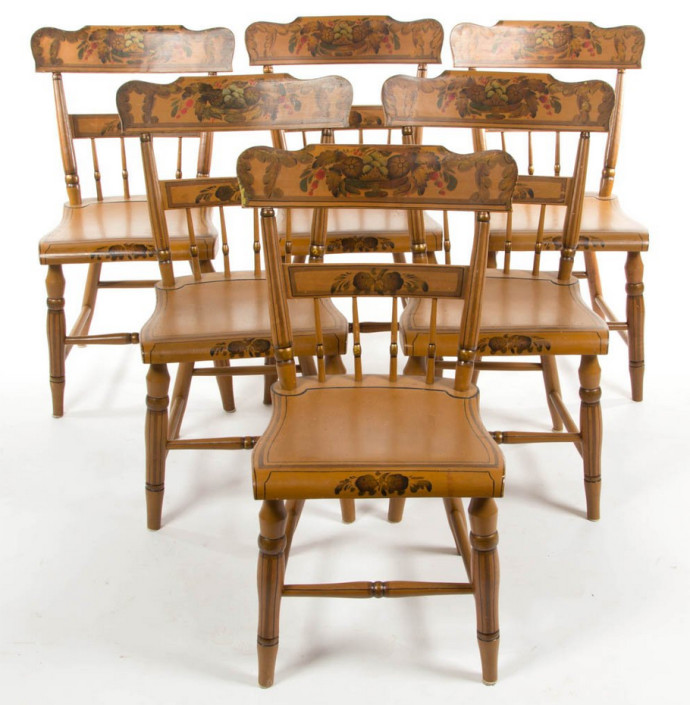
Signed Swint chairs as advertised by Jeffrey S. Evans & Assoc. auctioneers in Mt. Crawford, VA.
So I knew (minus transportation costs) what the seller paid for them. His margin was indeed small. By Sunday he had seen my email. We quickly agreed on a price for his set and what he would pay for mine. I would owe him the difference. Then he convinced me to see if I could fit my six into my Mazda sedan. Surprisingly they fit: two in the trunk, two in the back seat and two beside the driver. So I drove up to the antique show. He inspected my set in the parking lot and agreed to consummate the deal. And I drove home with the Swint set.
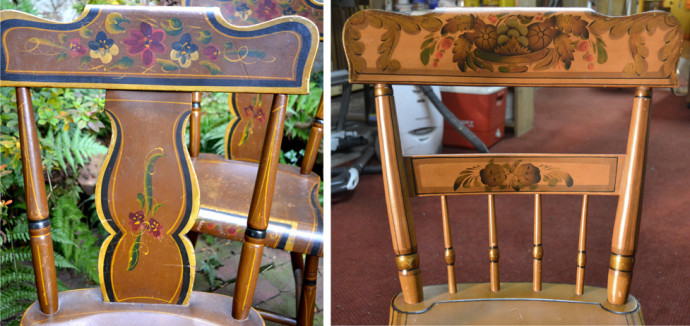
I find that the paint decoration on the Swint set (right) more sophisticated than the one (left) that I sold. Instead of entirely freehand ornamentation (on the left), the Swint painters began with stenciling, then added details by hand (see below). Also the center ornament on the Swint top rail is a fruit-filled compote, which acknowledges urban cabinet makers’ use of neoclassical designs. The shapelier front legs of the Swint set also relate to city-made fancy chairs, while the legs on the other set are barely more than sticks.
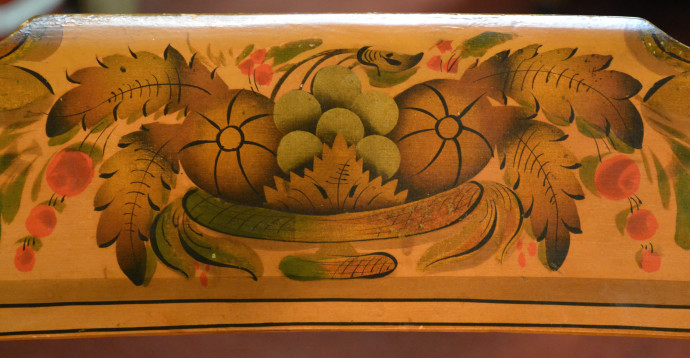
This style of ornamentation also appears on a settee we bought years ago. It was sold to us as made in Philadelphia or the lower Delaware Valley. The similarity is striking, especially in the detail work and shadowing.

Besides the upgrade in kitchen chair decoration, one the aspect of the Swint chairs that couldn’t be better is the signature that appears under the seat of one chair. John Swint often signed his chair with a blind stamp, but hand-signed? That’s exceptional.
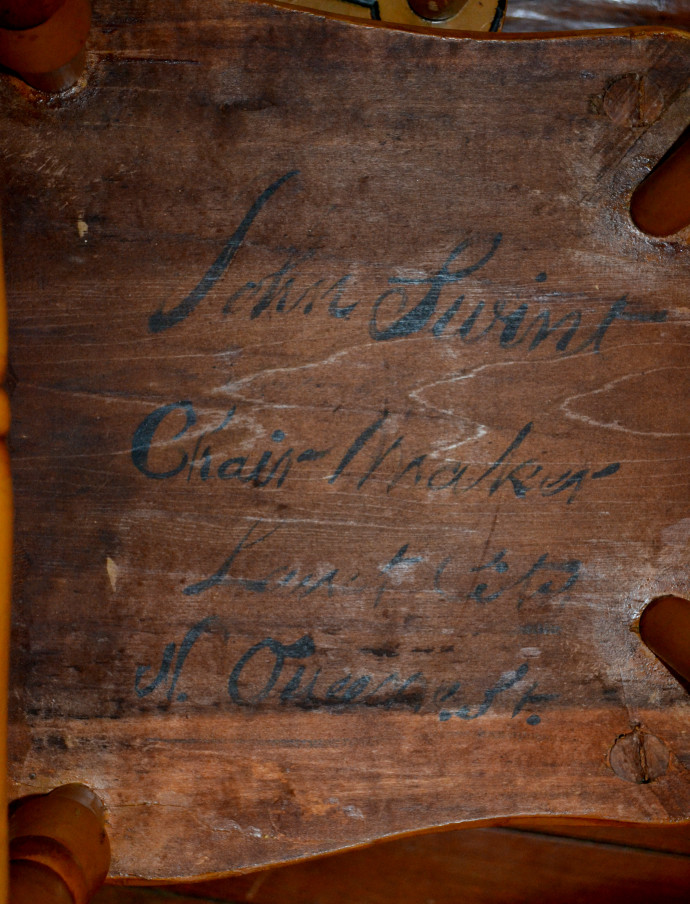
It reads: John Swint/Chair-Maker/Lancst. City/N. Queen St.
Federal Mirror
Once again I was seduced by the design and condition of an object when I spied a small mirror last spring at an antiques show at the Howard County Fairgrounds. (Alas the show was discontinued last fall.) We certainly didn’t need another mirror, but this one’s gilding was untouched and its composition relief elements were entirely intact. I first had to think where we were going to put it. This required the time to walk around the show once. By the second viewing, I convinced myself that the guest bedroom needed a mirror.
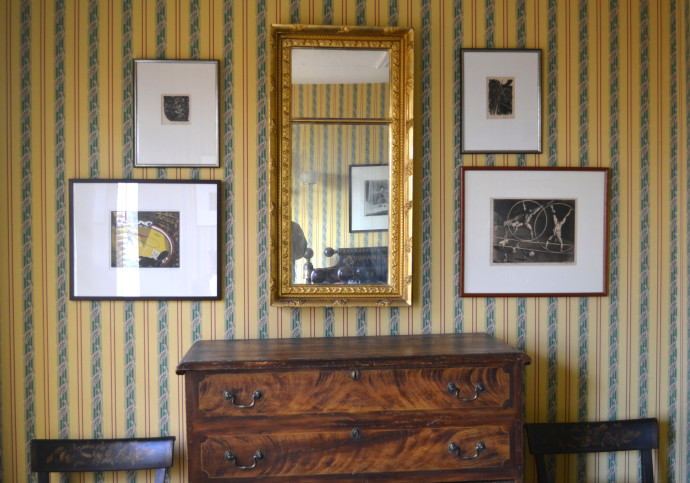
See? It fits perfectly in scale and decoration, i.e. like all of the furniture in the room its wood frame is hidden. In the mirror’s case it was by gilding. In the chest below it, it was by faux bois. In the chairs, it was by stenciling.

In structure the mirror is like a picture frame where the outer structure comes forward and the inner structure is recessed. Compare it to a mirror that hangs in the dining room pier. It is typical of 1820-30s mirrors with corner bosses (here quadtrefoils) and half-spindle sides. Both mirrors are in two sections. The guest room mirror has glass above; the dining room one has a plaque of a basket of flowers and fruit (another typical neoclassical motif).

The mirrors share a corkscrew design element. These twisted rods are finely delineated in the guest room mirror. Those on the dining room one are rather indistinct.

Interestingly, the acorn and oak leaf border in the guest room mirror can be found in a freestanding band of our over-mantle mirror in our bedroom. That mirror resided in a house on Maryland’s Eastern Shore until bought by a Centreville antiques dealer, who then decided not to pay a specialist to remove the radiator over-paint. She let me have at cost. Then I spend hours with acetone and Q-tips (and ventilation) cleaning it. You can see granules of paint that stubbornly cling to the leaves.
Glass Bowl
I’ve been attracted to what is generally called Pittsburgh glass ever since I attended a (long extinct) glass show in Silver spring, MD., 30 years ago. I loved the clarity of the lead (flint) glass and the boldness of the cutting. It would be safer to say the glass was made in the Midwest, but Pittsburgh and the renown of the Bakewell name has a way of making all similar glass “Pittsburgh.”

Here are four examples of “Pittsburgh” drinking vessels: (L to R) a finely cut v-shape wine with the sheaf-of-wheat pattern, a regular size wine, a tumbler, and a syllabub (made for a sweet concoction). All of the last three have what are called strawberry diamonds, fans and roundels with rays.
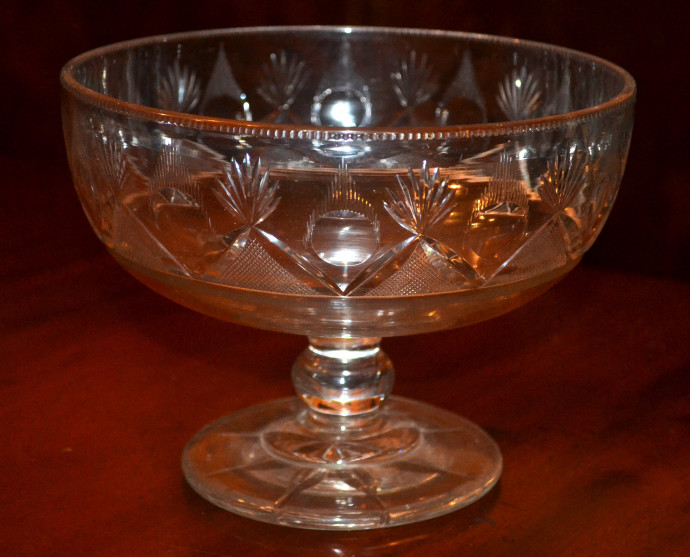
Display pieces like celeries (vases), decanters and (above) compotes (remember the painted version on the Swint chairs) were made in great numbers. But last January at a York, PA, show, I came across only the second Pittsburgh oval bowl I’ve seen (and bought).
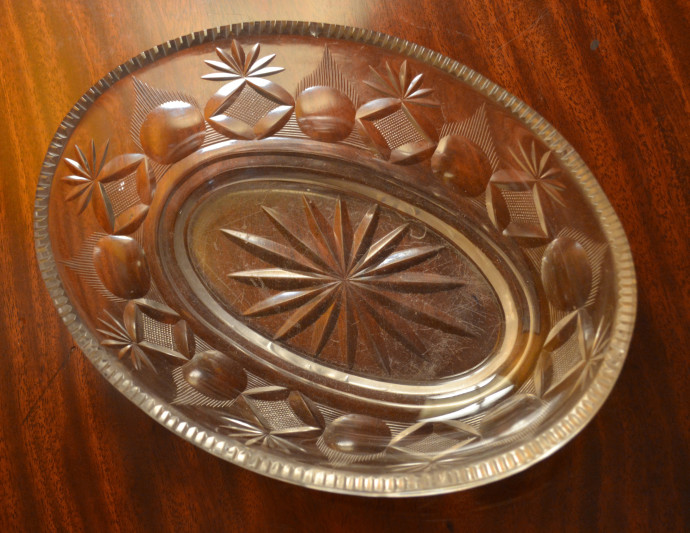
It wasn’t a great time for indulgences, but I’m a collector. I don’t need to explain further.

All photos are by Scott Ponemone, except the set of Swint chairs.
Trackback URL: https://www.scottponemone.com/2015-recap-decorative-arts/trackback/












I’m not buying and in fact would like to unload, but, Scott, i did enjoy the photos and descriptions of these wonderful American items.
Thanks
Happy New Year!